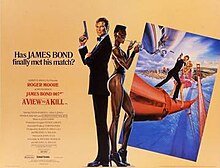Historical Context and Production
“A View to a Kill” premiered on the 22nd of May, 1985, marking a significant milestone in the James Bond franchise as the 14th film in the series. The mid-1980s was a period characterized by a blend of Cold War tension and burgeoning pop culture, which undoubtedly influenced the themes and tone of the movie. The film’s production coincided with global events that emphasized technological advancements and geopolitical intrigue, resonating within the espionage narrative of James Bond.
Roger Moore’s final portrayal of the iconic British spy added a layer of nostalgia and gravitas to the film. Having played the role since 1973, Moore’s departure was a momentous occasion for both the audience and the franchise. His suave demeanor and signature wit had become synonymous with James Bond, and “A View to a Kill” offered a fitting farewell to his era. The casting of Grace Jones as the formidable May Day and Christopher Walken as the villainous Max Zorin brought a fresh dynamic to the film. Jones’s striking presence and Walken’s chilling performance contributed to the movie’s distinctive character ensemble.
The production of “A View to a Kill” was not without its challenges. Filming took place in various locations, including the iconic city of San Francisco, whose landmarks such as the Golden Gate Bridge were prominently featured. These scenes required meticulous planning and coordination, presenting logistical hurdles that the cast and crew adeptly navigated. Interviews with the film’s director, John Glen, and other key figures reveal the complexities involved in bringing such an ambitious project to fruition.
External sources, such as interviews with Roger Moore and production notes, provide additional insights into the film’s development. These references, alongside historical context, enrich the understanding of how “A View to a Kill” was shaped by its time and contributed to the legacy of the James Bond franchise. For further reading, reliable sources such as [insert external link here] offer comprehensive details on the film’s production journey.
The premiere of “A View to a Kill” on May 22nd, 1985, marked a significant moment in the James Bond franchise, drawing both applause and criticism from various quarters. Upon its release, the film received mixed reviews from critics and audiences alike. While some praised the high-stakes action sequences and the performances of its main cast, others were less enthusiastic about the overall execution.
Critics lauded the film’s thrilling action scenes, particularly the climactic showdown atop the Golden Gate Bridge, which was seen as a fittingly dramatic conclusion for Roger Moore’s tenure as James Bond. Grace Jones and Christopher Walken, who played the film’s antagonists May Day and Max Zorin, respectively, were recognized for their dynamic and memorable portrayals. Their performances added a distinctive flavor to the movie, contributing to its uniqueness within the series.
However, the film was not without its detractors. Some reviewers felt that the plot was overly convoluted, and there was critique regarding the pacing and narrative coherence. Roger Moore’s final outing as the iconic spy was met with a mix of admiration and skepticism. While his charm and wit remained intact, some argued that his age was beginning to show, affecting the believability of his action scenes. Despite this, Moore’s legacy as James Bond remained strong, with many fans and critics appreciating his contribution to the character over seven films.
The enduring legacy of “A View to a Kill” is multifaceted. Despite its mixed initial reception, the film has maintained a place in popular culture, often cited for its memorable villains and the iconic theme song performed by Duran Duran. Retrospective analyses have been more forgiving, acknowledging the film’s strengths and its role in transitioning the franchise into a new era. Box office performance data revealed that the film was commercially successful, demonstrating the enduring appeal of the James Bond series during that period.
In the broader context of the Bond franchise, “A View to a Kill” serves as a pivotal moment, bridging the end of Roger Moore’s era and paving the way for Timothy Dalton’s portrayal. It remains a topic of discussion among fans and scholars, highlighting the complexities of maintaining a long-running film series.

